Origin of Quartz Diorite and Mafic Enclaves in the Delong Gold-Copper Deposit and Evaluation of the Gold-Copper Mineralization Potential
Abstract
:1. Introduction
2. Geological Setting and Deposit Geology
3. Petrography
4. Analytical Methods
4.1. Zircon U–Th-Pb-Hf Isotopes and Trace Element Analyses
4.2. Mineral Composition Analyses
4.3. Whole Rock Major, Trace Elements, and Sr-Nd Isotope Analyses
5. Results
5.1. Zircon U–Pb Ages
5.2. Major and Trace Element Geochemistry
5.3. Mineral Chemistry and Crystallization Conditions
5.3.1. Zircon
5.3.2. Hornblende
5.3.3. Biotite
5.3.4. Plagioclase
5.4. Whole Rock Sr-Nd Isotopes and Zircon Lu–Hf Isotopes
6. Discussion
6.1. Magma Mixing/Mingling
6.2. Sources of the Mafic Enclaves and Quartz Diorite
6.2.1. Sources of the Mafic Enclaves
6.2.2. Sources of the Diorite
6.3. Magma Fertility and Gold-Copper Mineralization Potential of the Eastern EKO
6.3.1. Water Content
6.3.2. Oxygen Fugacity
6.3.3. Gold-Copper Mineralization Potential of the Eastern EKO
7. Conclusions
Supplementary Materials
Author Contributions
Funding
Data Availability Statement
Acknowledgments
Conflicts of Interest
References
- Sillitoe, R.H. Porphyry Copper Systems. Econ. Geol. 2010, 105, 3–41. [Google Scholar] [CrossRef]
- Chiaradia, M. Gold endowments of porphyry deposits controlled by precipitation efficiency. Nat. Commun. 2020, 11, 248. [Google Scholar] [CrossRef]
- Lee, C.A.; Tang, M. How to make porphyry copper deposits. Earth Planet. Sci. Lett. 2020, 529, 115868. [Google Scholar] [CrossRef]
- Richards, J.P. Porphyry copper deposit formation in arcs: What are the odds. Geosphere 2021, 18, 130–155. [Google Scholar] [CrossRef]
- Wang, R.; Weinberg, R.F.; Collins, W.J.; Richards, J.P.; Zhu, D. Origin of postcollisional magmas and formation of porphyry Cu deposits in southern Tibet. Earth-Sci. Rev. 2018, 181, 122–143. [Google Scholar] [CrossRef]
- Hou, Z.Q.; Yang, Z.M.; Wang, R.J.; Zheng, Y.C. Further discussion on porphyry Cu-Mo-Au deposit formation in Chinese mainland. Earth Sci. Front. 2020, 27, 20–44, (In Chinese with English Abstract). [Google Scholar]
- Xiong, F.; Ma, C.; Zhang, J.; Liu, B.; Jiang, H.A. Reworking of old continental lithosphere: An important crustal evolution mechanism in orogenic belts, as evidenced by Triassic I-type granitoids in the East Kunlun orogen, Northern Tibetan Plateau. J. Geol. Soc. Lond. 2014, 171, 847–863. [Google Scholar] [CrossRef]
- Chen, J.J.; Wei, J.H.; Fu, L.B.; Li, H.; Zhou, H.Z.; Zhao, X.; Zhan, X.F.; Tan, J. Multiple sources of the Early Mesozoic Gouli batholith, Eastern Kunlun Orogenic Belt, northern Tibetan Plateau: Linking continental crustal growth with oceanic subduction. Lithos 2017, 292–293, 161–178. [Google Scholar] [CrossRef]
- Mo, X.X.; Luo, Z.H.; Deng, J.F.; Yu, X.H.; Liu, C.D.; Chen, H.W.; Yuan, W.M.; Liu, Y.H. Granitoids and crustal growth in the East-Kunlun Orogenic Belt. Geol. J. China Univ. 2007, 13, 403–414, (In Chinese with English Abstract). [Google Scholar]
- Dong, Y.; He, D.; Sun, S.; Liu, X.; Zhou, X.; Zhang, F.; Yang, Z.; Cheng, B.; Zhao, G.; Li, J. Subduction and accretionary tectonics of the East Kunlun orogen, western segment of the Central China Orogenic System. Earth-Sci. Rev. 2018, 186, 231–261. [Google Scholar] [CrossRef]
- Zhang, J.Y.; Yang, Z.B.; Zhang, H.; Ma, C.Q.; Li, J.W.; Pan, Y.M. Controls on the formation of Cu-rich magmas: Insights from the Late Triassic post-collisional Saishitang complex in the eastern Kunlun Orogen, western China. Lithos 2017, 278, 400–418. [Google Scholar] [CrossRef]
- Zhong, S.; Li, S.; Feng, C.; Liu, Y.; Santosh, M.; He, S.; Qu, H.; Liu, G.; Seltmann, R.; Lai, Z.; et al. Porphyry copper and skarn fertility of the northern Qinghai-Tibet Plateau collisional granitoids. Earth-Sci. Rev. 2021, 214, 103524. [Google Scholar] [CrossRef]
- Chen, J.J.; Fu, L.B.; Wei, J.H.; Selby, D.; Zhang, D.H.; Zhou, H.Z.; Zhao, X.; Liu, Y. Proto-Tethys magmatic evolution along northern Gondwana: Insights from Late Silurian–Middle Devonian A-type magmatism, East Kunlun Orogen, Northern Tibetan Plateau, China. Lithos 2020, 356–357, 105304. [Google Scholar] [CrossRef]
- Chen, J.; Leng, C.; Fu, L.; Zhao, X.; Xing, H. Genesis of Delong Granite in East Kunlun Orogen and Its Implication on the Evolution of Paleo–Tethys Ocean. Earth Sci. 2023, 1–17, (In Chinese with English Abstract). [Google Scholar] [CrossRef]
- Xia, R.; Wang, C.; Qing, M.; Li, W.; Carranza, E.J.M.; Guo, X.; Ge, L.; Zeng, G. Zircon U–Pb dating, geochemistry and Sr–Nd–Pb–Hf–O isotopes for the Nan’getan granodiorites and mafic microgranular enclaves in the East Kunlun Orogen: Record of closure of the Paleo-Tethys. Lithos 2015, 234–235, 47–60. [Google Scholar] [CrossRef]
- Li, R.; Pei, X.; Li, Z.; Pei, L.; Chen, G.; Liu, Z.; Chen, Y.; Liu, C.; Wang, M.; Zhang, M. Paleo-Tethyan Ocean Evolution and Indosinian Orogenesis in the East Kunlun Orogen, Northern Tibetan Plateau. Minerals 2022, 12, 1590. [Google Scholar] [CrossRef]
- Chen, J.; Fu, L.; Wei, J.; Tian, N.; Xiong, L.; Zhao, Y.; Zhang, Y.; Qi, Y. Geochemical characteristics of Late Ordovician granodiorite in Gouli area, Eastern Kunlun Orogenic Belt, Qinghai province: Implications on the evolution of Proto-Tethys Ocean. Earth Sci. 2016, 41, 1863–1882, (In Chinese with English Abstract). [Google Scholar]
- Kong, J.; Niu, Y.; Hu, Y.; Zhang, Y.; Shao, F. Petrogenesis of the Triassic granitoids from the East Kunlun Orogenic Belt, NW China: Implications for continental crust growth from syn-collisional to post-collisional setting. Lithos 2020, 364–365, 105513. [Google Scholar] [CrossRef]
- Xia, R.; Wang, C.; Qing, M.; Deng, J.; Carranza, E.J.M.; Li, W.; Guo, X.; Ge, L.; Yu, W. Molybdenite Re-Os, zircon U-Pb dating and Hf isotopic analysis of the Shuangqing Fe-Pb-Zn-Cu skarn deposit, East Kunlun Mountains, Qinghai Province, China. Ore Geol. Rev. 2015, 66, 114–131. [Google Scholar] [CrossRef]
- Qu, H.; Friehauf, K.; Santosh, M.; Pei, R.; Li, D.; Liu, J.; Zhou, S.; Wang, H. Middle–Late Triassic magmatism in the Hutouya Fe–Cu–Pb–Zn deposit, East Kunlun Orogenic Belt, NW China: Implications for geodynamic setting and polymetallic mineralization. Ore Geol. Rev. 2019, 113, 103088. [Google Scholar] [CrossRef]
- Zong, K.; Reiner, K.; Yuan, Y.; He, Z.; Guo, J.; Shi, X.; Liu, Y.; Hu, Z.; Zhang, Z. The assembly of Rodinia: The correlation of early Neoproterozoic (ca. 900 Ma) high grade metamorphism and continental arc formation in the southern Beishan Orogen, southern Central Asian orogenic belt (CAOB). Precambrian Res. 2017, 290, 32–48. [Google Scholar] [CrossRef]
- Liu, Y.S.; Hu, Z.C.; Gao, C.G.; Gao, S.; Günther, D.; Xu, J.; Gao, C.G.; Chen, H.H. In situ analysis of major and trace elements of anhydrous minerals by LA-ICP-MS without applying an internal standard. Chem. Geol. 2008, 257, 34–43. [Google Scholar] [CrossRef]
- Vermeesch, P. IsoplotR: A free and open toolbox for geochronology. Geosci. Front. 2018, 9, 1479–1493. [Google Scholar] [CrossRef]
- Hu, Z.; Liu, Y.; Gao, S.; Liu, W.; Yang, L.; Zhang, W.; Tong, X.; Lin, L.; Zong, K.; Li, M.; et al. Improvedin situ Hf isotope ratio analysis of zircon using newly designed X skimmer coneand Jet sample cone in combination with the addition of nitrogen by laser ablation multiple collector ICP-MS. J. Anal. Atom. Spectrom. 2012, 27, 1391–1399. [Google Scholar] [CrossRef]
- Blichert-Toft, J.; Albarède, F. Separation of Hf and Lu for high-precision isotope analysis of rock samples by magnetic sector-multiple collector ICP-MS. Contrib. Mineral. Petrol. 1997, 127, 248–260. [Google Scholar] [CrossRef]
- Griffin, W.L.; Pearson, N.J.; Belousova, E.; Jackson, S.E.; Achterbergh, E.V.; O’Reilly, S.Y.; Shee, S.R. The Hf isotope composition of cratonic mantle: LAM-MC-ICPMS analysis of zircon megacrysts in kimberlites. Geochim. Cosmochim. Acta 2000, 64, 133–147. [Google Scholar] [CrossRef]
- Söderlund, U.; Patchett, P.J.; Vervoort, J.D.; Isachsen, C.E. The 176Lu decay constant determined by Lu–Hf and U–Pb isotope systematics of Precambrian mafic intrusions. Earth Planet. Sci. Lett. 2004, 219, 311–324. [Google Scholar] [CrossRef]
- Gao, S.; Rudnick, R.L.; Yuan, H.L.; Liu, X.M.; Liu, Y.S.; Xu, W.L.; Ling, W.L.; Ayers, J.; Wang, X.C.; Wang, Q.H. Recycling lower continental crust in the North China craton. Nature 2004, 432, 892–897. [Google Scholar] [CrossRef]
- Steiger, R.H.; Jäger, E. Subcommission on geochronology: Convention on the use of decay constants in geo- and cosmochronology. Earth Planet. Sci. Lett. 1977, 36, 359–362. [Google Scholar] [CrossRef]
- Lugmair, G.W.; Marti, K. Lunar initial 143 Nd/144 Nd: Differential evolution of the lunar crust and mantle. Earth Planet. Sci. Lett. 1978, 39, 349–357. [Google Scholar] [CrossRef]
- Wu, Y.B.; Zheng, Y.F. Genesis of zircon and its constraints on interpretation of U-Pb age. Chin. Sci. Bull. 2004, 49, 1589–1604, (In Chinese with English Abstract). [Google Scholar] [CrossRef]
- Middlemost, E.A.K. Naming materials in the magma/igneous rock system. Earth-Sci. Rev. 1994, 37, 215–224. [Google Scholar] [CrossRef]
- Frost, B.R. A geochemical classification for granitic rocks. J. Petrol. 2001, 42, 2033–2048. [Google Scholar] [CrossRef]
- Peccerillo, R.; Taylor, S.R. Geochemistry of Eocene calc-alkaline volcanic rocks from the Kastamonu area, Northern Turkey. Contrib. Mineral. Petrol. 1976, 58, 63–81. [Google Scholar] [CrossRef]
- Maniar, P.D.; Piccoli, P.M. Tectonic discrimination of granitoids. Geol. Soc. Am. Bull. 1989, 101, 635–643. [Google Scholar] [CrossRef]
- Rudnick, R.L.; Gao, S. Composition of the continental crust. In The Crust; Holland, H.D., Turekian, K.K., Eds.; Elsevier-Pergamon: Oxford, UK, 2003; pp. 1–64. [Google Scholar]
- Sun, S.S.; McDonough, W.F. Chemical and isotopic systematics of oceanic basalts: Implications for mantle composition and processes. Geol. Soc. Lond. Spec. Publ. 1989, 42, 313–345. [Google Scholar] [CrossRef]
- Ferry, J.M.; Watson, E.B. New thermodynamic models and revised calibrations for the Ti-in-zircon and Zr-in-rutile thermometers. Contrib. Mineral. Petrol. 2007, 154, 429–437. [Google Scholar] [CrossRef]
- Li, W.; Cheng, Y.; Yang, Z. Geo-fO2: Integrated Software for Analysis of Magmatic Oxygen Fugacity. Geochem. Geophys. Geosyst. 2019, 20, 2542–2555. [Google Scholar] [CrossRef]
- Zou, X.; Qin, K.; Han, X.; Li, G.; Evans, N.J.; Li, Z.; Yang, W. Insight into zircon REE oxy-barometers: A lattice strain model perspective. Earth Planet. Sci. Lett. 2019, 506, 87–96. [Google Scholar] [CrossRef]
- Trail, D.; Watson, E.B.; Tailby, N.D. The oxidation state of Hadean magmas and implications for early Earth’s atmosphere. Nature 2011, 480, 79–82. [Google Scholar] [CrossRef]
- Li, S.; Liu, X.; Lu, Y.; Zhang, S.; Liu, S.; Chen, J.; Li, Z.; Yu, H.; Zhang, C. Indication of Zircon Oxygen Fugacity to Different Mineralization Control Factors of Porphyry Deposits in Zhongdian Ore-Concentrated Area, Southern Yidun Arc. Earth Sci. 2022, 47, 1435–1458, (In Chinese with English Abstract). [Google Scholar]
- Chen, G.C.; Pei, X.Z.; Li, R.B.; Li, Z.C.; Liu, C.J.; Chen, Y.X.; Pei, L.; Zhang, Y.M.; Wang, M.; Li, X.B.; et al. Age and Petrogenesis of Jialuhe Basic-Intermediate Pluton in Xiangjia’nanshan Granite Batholith in the Eastern Part of East Kunlun Orogenic Belt, and its Geological Significance. Geotecton. Metallog. 2017, 41, 1097–1115, (In Chinese with English Abstract). [Google Scholar]
- Trail, D.; Bruce Watson, E.; Tailby, N.D. Ce and Eu anomalies in zircon as proxies for the oxidation state of magmas. Geochim. Cosmochim. Acta 2012, 97, 70–87. [Google Scholar] [CrossRef]
- Lu, Y.; Loucks, R.R.; Fiorentini, M.L.; McCuaig, T.C.; Evans, N.J.; Zhiming, Y.; Zengqian, H.; Kirkland, C.L.; Parra-Avila, L.A.; Kobussen, A.; et al. Zircon compositions as a pathfinder for porphyry Cu ± Mo ± Au mineral deposits. Spec. Publ. Soc. Econ. Geol. 2016, 19, 329–348. [Google Scholar]
- Shen, P.; Hattori, K.; Pan, H.; Jackson, S.; Seitmuratova, E. Oxidation Condition and Metal Fertility of Granitic Magmas: Zircon Trace-Element Data from Porphyry Cu Deposits in the Central Asian Orogenic Belt. Econ. Geol. 2015, 110, 1861–1878. [Google Scholar] [CrossRef]
- Leake, B.E. Nomenclature of Amphiboles: Report of the Subcommittee on Amphiboles of the International Mineralogical Association Commission on New Minerals and Mineral Names. Can. Mineral. 1997, 61, 295–321. [Google Scholar]
- Ridolfi, F.; Renzulli, A.; Puerini, M. Stability and chemical equilibrium of amphibole in calc-alkaline magmas: An overview, new thermobarometric formulations and application to subduction-related volcanoes. Contrib. Mineral. Petrol. 2010, 160, 45–66. [Google Scholar] [CrossRef]
- Xiong, F.H. Spatial-Temporal Pattern, Petrogenesis and Geological Implications of Paleo-Tethyan Granitoids in the East Kunlun Orogenic belt (Eastern Segment); China University of Geosciences: Wuhan, China, 2014; pp. 1–191. [Google Scholar]
- O’Neill, H.S.C.; Pownceby, M.I. Thermodynamic data from redox reactions at high temperatures. I. An experimental and theoretical assessment of the electrochemical method using stabilized zirconia electrolytes, with revised values for the Fe-“FeO”, Co-CoO, Ni-NiO and Cu-Cu2O oxygen buffers, and new data for the W-WO2 buffer. Contrib. Mineral. Petrol. 1993, 114, 296–314. [Google Scholar]
- Henry, D.J.; Guidotti, C.V.; Thomson, J.A. The Ti-saturation surface for low-to-medium pressure metapelitic biotites: Implications for geothermometry and Ti-substitution mechanisms. Am. Mineral. 2005, 90, 316–328. [Google Scholar] [CrossRef]
- Uchida, E.; Endo, S.; Makino, M. Relationship Between Solidification Depth of Granitic Rocks and Formation of Hydrothermal Ore Deposits. Resour. Geol. 2007, 57, 47–56. [Google Scholar] [CrossRef]
- Foster, M.D. Interpretation of the Composition of Trioctahedral Micas; U.S. Geological Survey Professional Paper 354-B; U.S. Government Publishing Office: Washington, DC, USA, 1960; pp. 1–146. [Google Scholar]
- Nachit, H.; Ibhi, A.; Abia, E.H.; Ben Ohoud, M. Discrimination between primary magmatic biotites, reequilibrated biotites and neoformed biotites. Comptes Rendus Geosci. 2005, 337, 1415–1420. [Google Scholar] [CrossRef]
- Wones, D.R.; Eugster, H.P. Stability of biotite; experiment, theory, and application. Am. Mineral. 1965, 50, 1228–1272. [Google Scholar]
- Vervoort, J.D.; Patchett, P.J.; Blichert-Toft, J.; Albarède, F. Relationships between Lu–Hf and Sm–Nd isotopic systems in the global sedimentary system. Earth Planet. Sci. Lett. 1999, 168, 79–99. [Google Scholar] [CrossRef]
- Guo, A.L.; Zhang, G.W.; Sun, Y.G.; Cheng, S.Y.; Yao, A.P. Geochemistry and spatial distribution of late-Paleozoic mafic volcanic rocks in the surrounding areas of the Gonghe Basin: Implications for Majixueshan triple-junction and east Paleotethyan archipelagic ocean. Science China. Earth Sci. 2007, 50, 292–304. [Google Scholar] [CrossRef]
- Yu, N.; Jin, W.; Ge, W.C.; Long, X.P. Geochemical study on peraluminous granite from Jinshuikou in East Kunlun. Glob. Geol. 2005, 24, 123–128, (In Chinese with English Abstract). [Google Scholar]
- Long, X.P. The Research of Zircon Chronology in Orogenic Belts—A Case Study in Jinshuikou Zone. Master’s Thesis, Jilin University, Changchun, China, 2004; p. 129. [Google Scholar]
- He, D.F.; Dong, Y.P.; Zhang, F.F.; Yang, Z.; Sun, S.S.; Cheng, B.; Zhou, B.; Liu, X.M. The 1.0 Ga S–type granite in the East Kunlun Orogen, Northern Tibetan Plateau: Implications for the Meso–to Neoproterozoic tectonic evolution. J. Asian Earth Sci. 2016, 130, 46–59. [Google Scholar] [CrossRef]
- Zhao, X.; Fu, L.; Wei, J.; Zhao, Y.; Tang, Y.; Yang, B.; Guan, B.; Wang, X. Geochemical characteristics of the An’nage hornblende gabbro from East Kunlun Orogenic Belt: Constraints on the evolution of Paleo-Tethys Ocean. Earth Sci. 2018, 43, 1–23, (In Chinese with English Abstract). [Google Scholar]
- Hu, Y.; Niu, Y.; Li, J.; Ye, L.; Kong, J.; Chen, S.; Zhang, Y.; Zhang, G. Petrogenesis and tectonic significance of the late Triassic mafic dikes and felsic volcanic rocks in the East Kunlun Orogenic Belt, Northern Tibet Plateau. Lithos 2016, 245, 205–222. [Google Scholar] [CrossRef]
- Xiong, F.; Ma, C.; Jiang, H.; Liu, B.; Zhang, J.; Zhou, Q. Petrogenetic and tectonic significance of Permian calc-alkaline lamprophyres, East Kunlun orogenic belt, Northern Qinghai-Tibet Plateau. Int. Geol. Rev. 2013, 55, 1817–1834. [Google Scholar] [CrossRef]
- Zhang, Z.; Wang, Y.; Qian, B.; Liu, Y.; Zhang, D.; Lü, P.; Dong, J. Metallogeny and tectonomagmatic setting of Ni-Cu magmatic sulfide mineralization, number I Shitoukengde mafic-ultramafic complex, East Kunlun Orogenic Belt, NW China. Ore Geol. Rev. 2018, 96, 236–246. [Google Scholar] [CrossRef]
- Zhao, X.; Fu, L.; Wei, J.; Bagas, L.; Santosh, M.; Liu, Y.; Zhang, D.; Zhou, H. Late Permian back-arc extension of the eastern Paleo-Tethys Ocean: Evidence from the East Kunlun Orogen, Northern Tibetan Plateau. Lithos 2019, 340–341, 34–48. [Google Scholar] [CrossRef]
- Kong, H.; Li, Y.; Li, J.; Jia, Q.; Guo, X.; Wang, Y.; Yao, X. Petrogenesis of Xiwanggou olivine gabbro in East Kunlun Mountains: Constraints from geochemistry, zircon U-Pb dating and Hf isotopes. Geol. China 2021, 48, 173–188, (In Chinese with English Abstract). [Google Scholar]
- Huang, H.; Niu, Y.; Nowell, G.; Zhidan, Z.; Xuehui, Y.; Dicheng, Z.; Xuanxue, M.; Shuo, D. Geochemical constraints on the petrogenesis of granitoids in the East Kunlun orogenic belt, northern Tibetan Plateau; implications for continental crust growth through syn-collisional felsic magmatism. Chem. Geol. 2014, 370, 1–18. [Google Scholar] [CrossRef]
- Fu, L.; Wei, J.; Tan, J.; Santosh, M.; Zhang, D.; Chen, J.; Li, Y.; Zhao, S.; Peng, L. Magma mixing in the Kalaqin core complex, northern North China Craton: Linking deep lithospheric destruction and shallow extension. Lithos 2016, 260, 390–412. [Google Scholar] [CrossRef]
- Ma, C.Q. Advances in Study on the Interaction between Mafic and Felsic Magmas in Orogenic Suites. Geol. Sci. Technol. Inf. 2003, 22, 1–8, (In Chinese with English Abstract). [Google Scholar]
- Zhang, Q.; Pan, G.Q.; Li, C.D.; Jin, W.J.; Jia, X.Q. Granitic magma mixing versus basaltic magma mixing: New viewpoints on granitic magma mixing precess: Song crucial quertions on granite study (1). Acta Petrol. Sin. 2007, 23, 1141–1152, (In Chinese with English Abstract). [Google Scholar]
- Guo, A.L.; Zhang, G.W.; Sun, Y.G.; Cheng, Y.S.; Qiang, J. Sr-Nd-Pb isotopic geochemistry of late-Paleozoic mafic volcanic rocks in the surrounding areas of Gonghe basin, Qinghai Province and geological implications. Acta Petrol. Sin. 2007, 23, 747–754, (In Chinese with English Abstract). [Google Scholar]
- Defant, M.J.; Drummond, M.S. Derivation of some modern arc magmas by melting of young subducted lithosphere. Nature 1990, 347, 662–665. [Google Scholar] [CrossRef]
- Chen, S.; Niu, Y.L.; Li, J.Y.; Sun, W.L.; Zhang, Y.; Hu, Y.; Shao, F.L. Syn-collisional adakitic granodiorites formed by fractional crystallization: Insights from their enclosed mafic magmatic enclaves (MMEs) in the Qumushan pluton, North Qilian Orogen at the northern margin of the Tibetan Plateau. Lithos 2016, 248–251, 455–468. [Google Scholar] [CrossRef]
- Ding, Q.; Jiang, S.; Sun, F. Zircon U–Pb geochronology, geochemical and Sr–Nd–Hf isotopic compositions of the Triassic granite and diorite dikes from the Wulonggou mining area in the Eastern Kunlun Orogen, NW China: Petrogenesis and tectonic implications. Lithos 2014, 205, 266–283. [Google Scholar] [CrossRef]
- Richards, J.P. Postsubduction porphyry Cu-Au and epithermal Au deposits: Products of remelting of subduction-modified lithosphere. Geology 2009, 37, 247–250. [Google Scholar] [CrossRef]
- Li, W.; Yang, Z.; Cao, K.; Lu, Y.; Sun, M. Redox-controlled generation of the giant porphyry Cu–Au deposit at Pulang, southwest China. Contrib. Mineral. Petrol. 2019, 174, 12. [Google Scholar] [CrossRef]
- Moore, G.; Carmichael, I.S.E. The hydrous phase equilibria (to 3 kbar) of an andesite and basaltic andesite from western Mexico; constraints on water content and conditions of phenocryst growth. Contrib. Mineral. Petrol. 1998, 130, 304–319. [Google Scholar] [CrossRef]
- Zhu, J.; Hu, R.; Bi, X.; Hollings, P.; Zhong, H.; Gao, J.; Pan, L.; Huang, M.; Wang, D. Porphyry Cu fertility of eastern Paleo-Tethyan arc magmas: Evidence from zircon and apatite compositions. Lithos 2022, 424–425, 106775. [Google Scholar] [CrossRef]
- Loucks, R.R.; Fiorentini, M.L.; Henríquez, G.J. New magmatic oxybarometer using trace elements in zircon. J. Petrol. 2020, 61, egaa034. [Google Scholar] [CrossRef]
- Chen, G.C.; Pei, X.Z.; Li, R.B.; Li, Z.C.; Liu, C.J.; Chen, Y.X.; Pei, L.; Zhang, Y.M.; Wang, M.; Zhang, Y.; et al. Mineralogical features of the amphiboles and biotites on the quartz xenocrysts rim of Jialuhe intermediate-basic pluton, eastern East Kunlun Orogen: Constraints on the magma mixing and mingling process. Earth Sci. Front. 2017, 24, 10–24, (In Chinese with English Abstract). [Google Scholar]
- Zhang, J.; Ma, C.; Li, J.; Pan, Y. A possible genetic relationship between orogenic gold mineralization and post-collisional magmatism in the eastern Kunlun Orogen, western China. Ore Geol. Rev. 2017, 81, 342–357. [Google Scholar] [CrossRef]
- Liang, G.; Yang, K.; Sun, W.; Fan, H.; Li, X.; Lan, T.; Hu, H.; Chen, Y. Multistage ore-forming processes and metal source recorded in texture and composition of pyrite from the Late Triassic Asiha gold deposit, Eastern Kunlun Orogenic Belt, Western China. J. Asian Earth Sci. 2021, 220, 104920. [Google Scholar] [CrossRef]
- Wu, J.; Zeng, Q.; Santosh, M.; Fan, H.; Wei, Z.; Yang, K.; Zhang, Z.; Li, X.; Liang, G. Intrusion-related orogenic gold deposit in the East Kunlun belt, NW China: A multiproxy investigation. Ore Geol. Rev. 2021, 139, 104550. [Google Scholar] [CrossRef]
- Lu, Y.; Kerrich, R.; Kemp, A.I.S.; McCuaig, T.C.; Zengqian, H.; Hart, C.J.R.; Li, Z.; Cawood, P.A.; Bagas, L.; Zhiming, Y.; et al. Intracontinental Eocene-Oligocene porphyry Cu mineral systems of Yunnan, western Yangtze Craton, China; compositional characteristics, sources, and implications for continental collision metallogeny. Econ. Geol. 2013, 108, 1541–1576. [Google Scholar] [CrossRef]
- Dilles, J.H.; Kent, A.J.R.; Wooden, J.L.; Tosdal, R.M.; Koleszar, A.; Lee, R.G.; Farmer, L.P. Zircon compositional evidence for sulfur-degassing from ore-forming arc magmas. Econ. Geol. 2015, 110, 241–251. [Google Scholar] [CrossRef]
- Watson, E.B.; Harrison, T.M. Zircon saturation revisited: Temperature and composition effects in a variety of crustal magma types. Earth Planet. Sci. Lett. 1983, 64, 295–304. [Google Scholar]
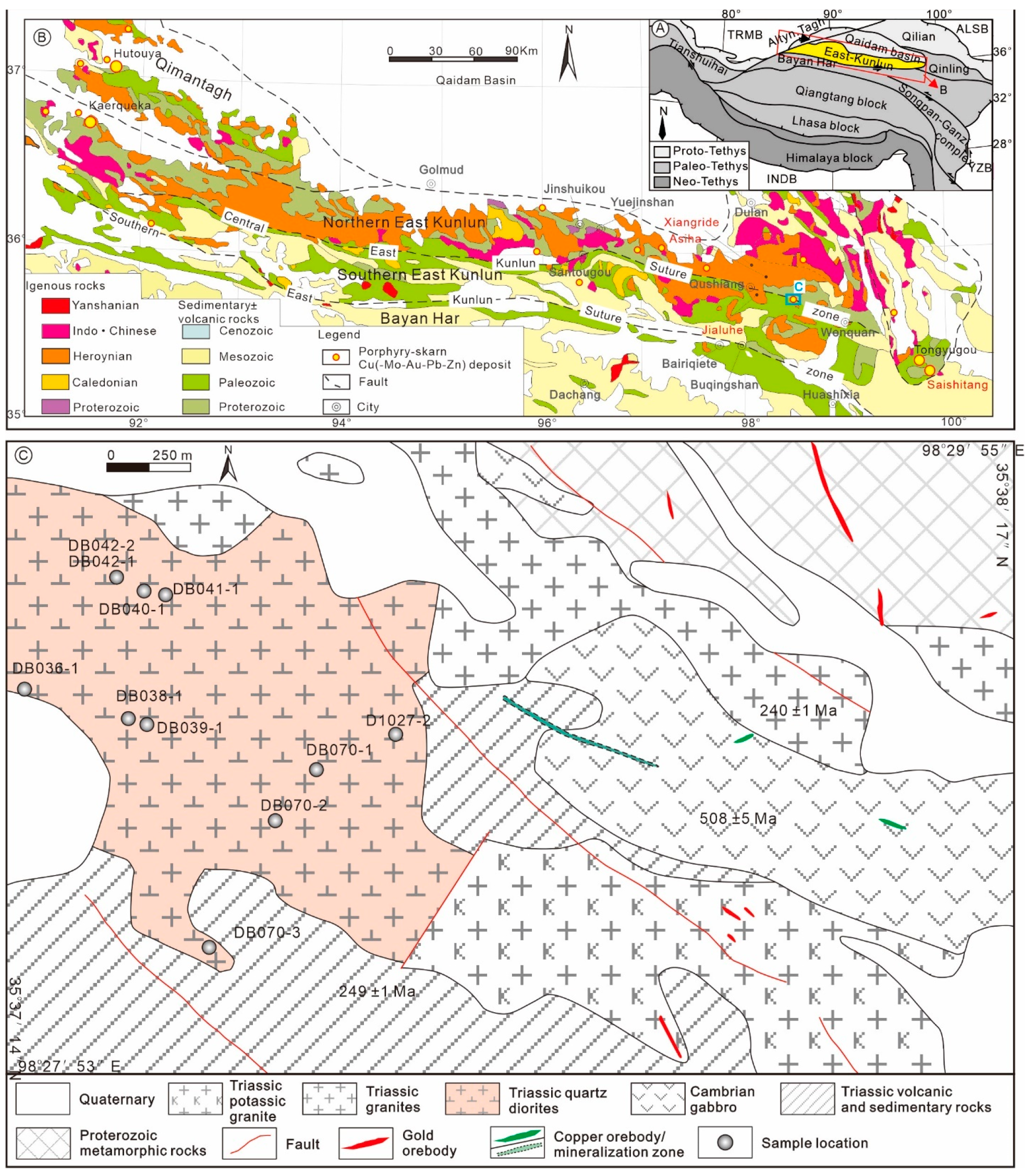


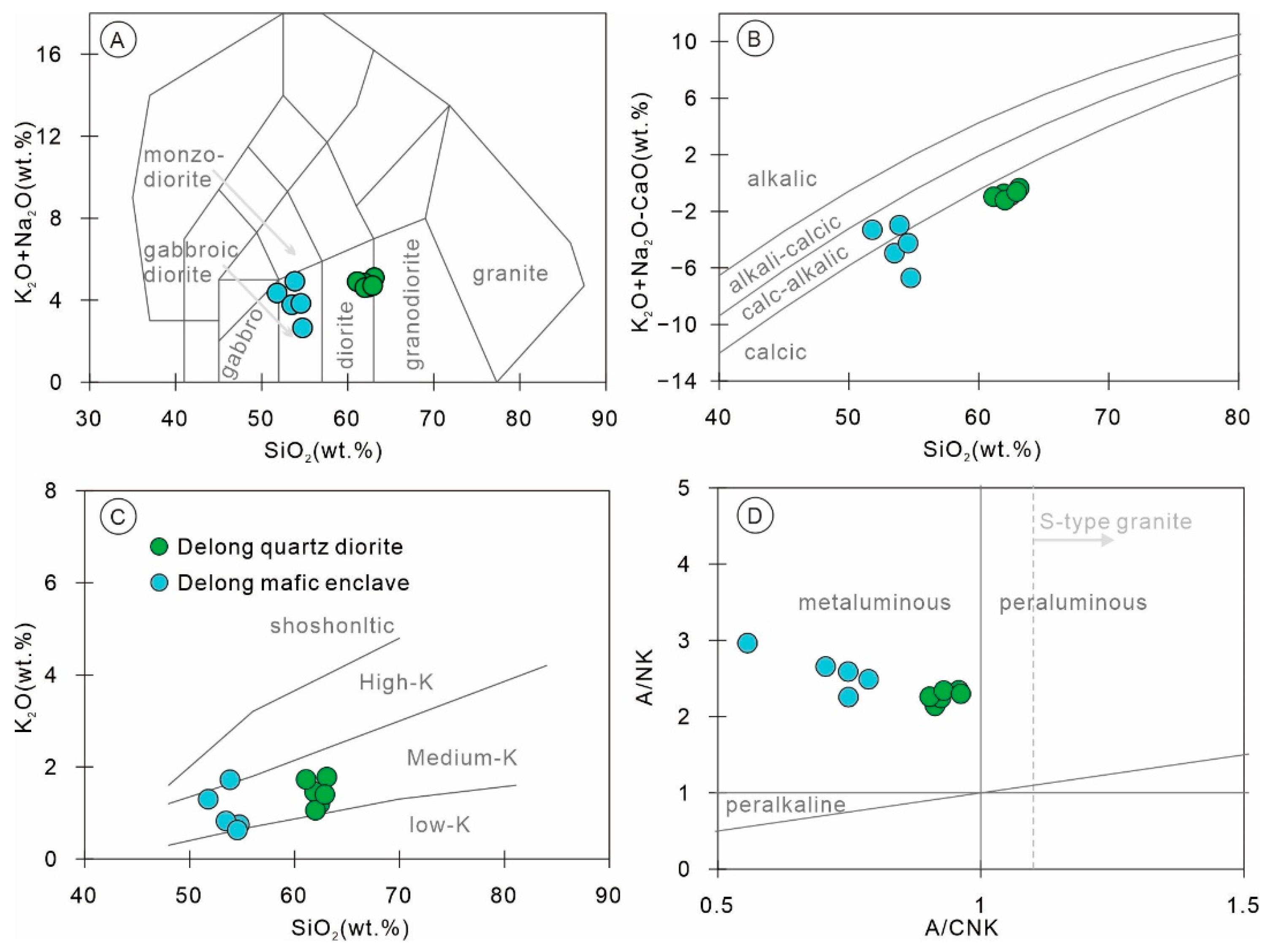
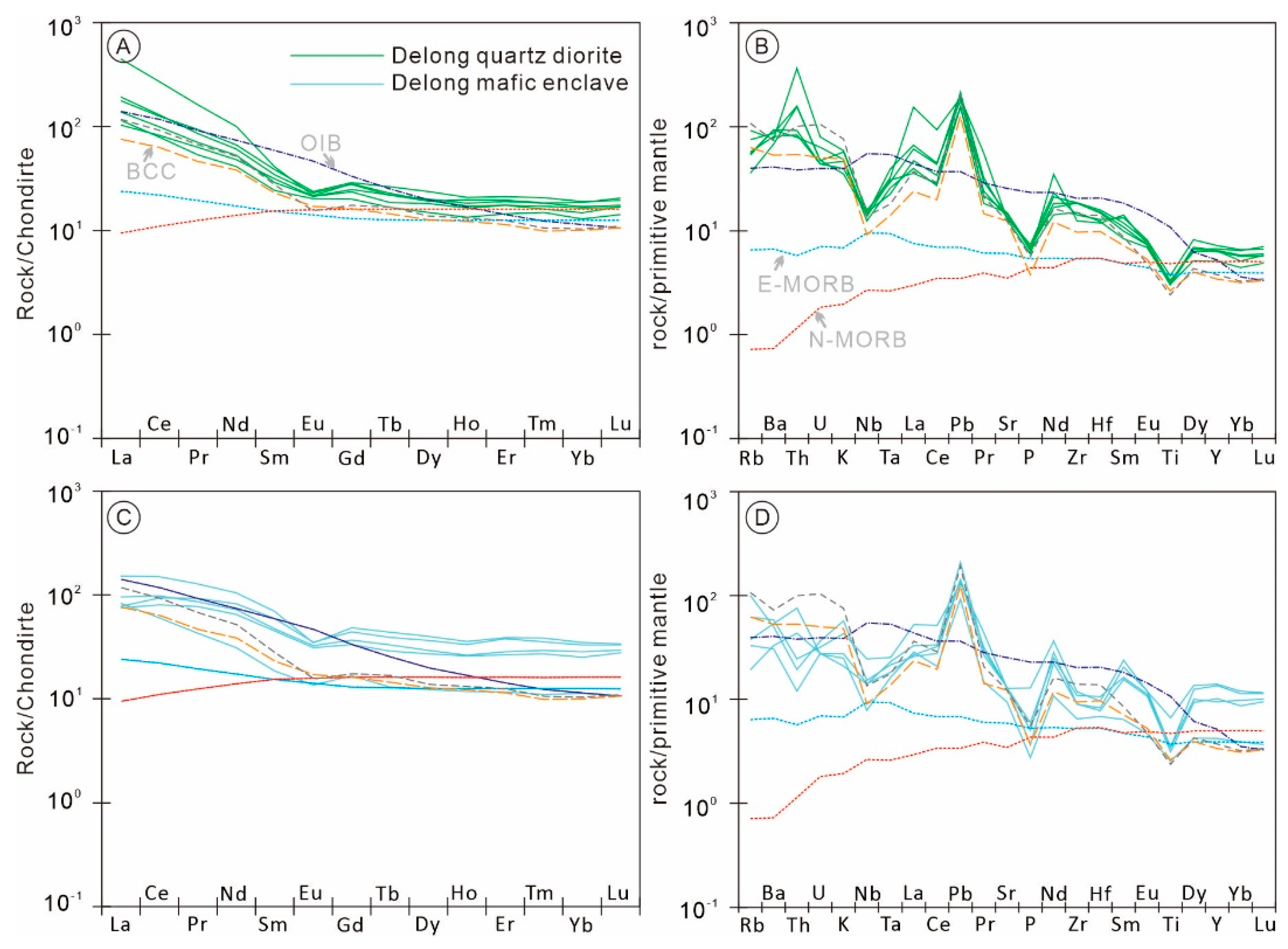
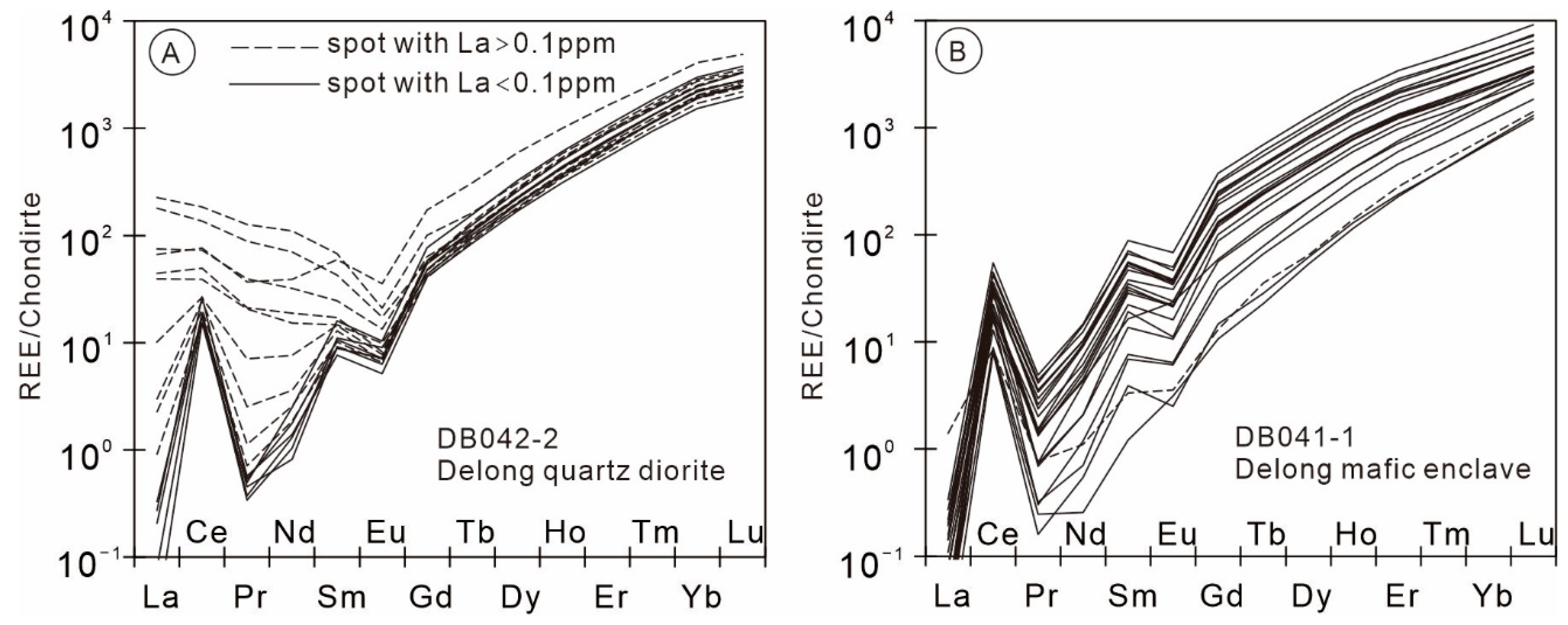

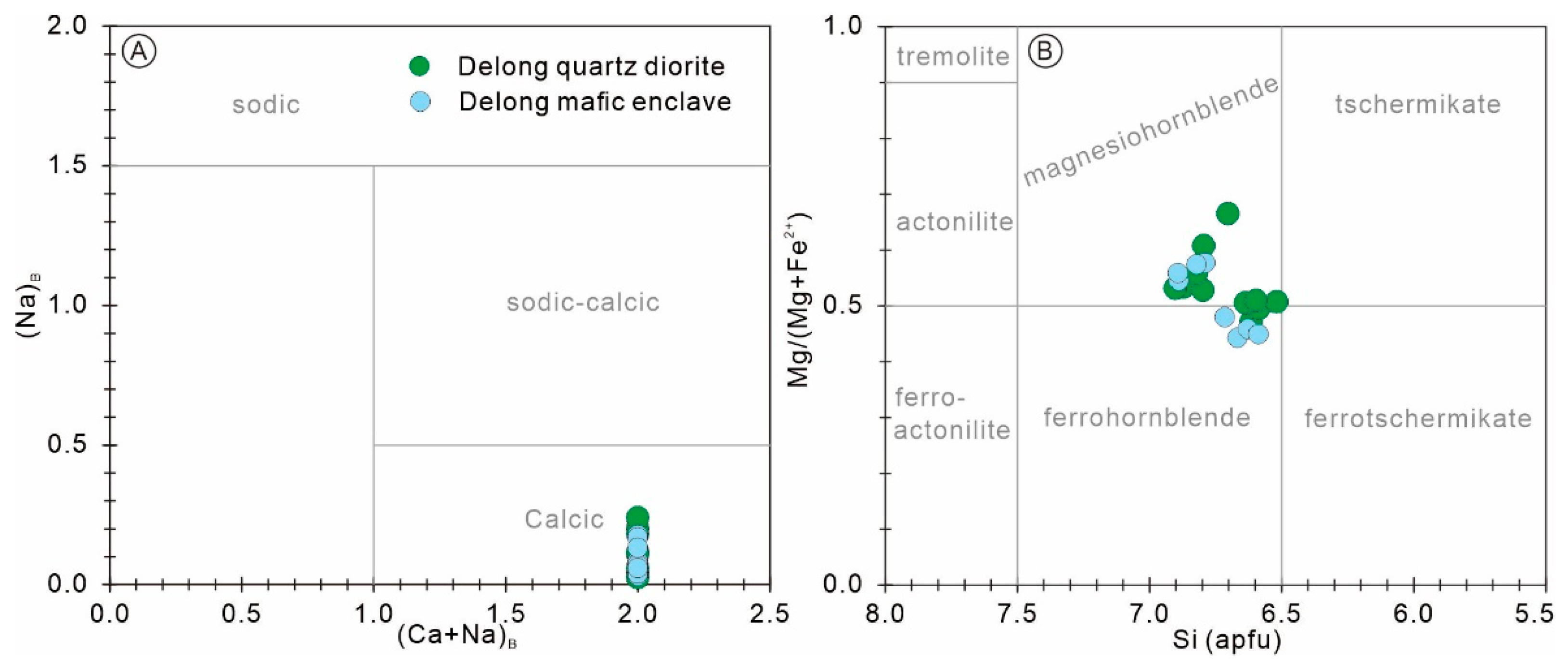

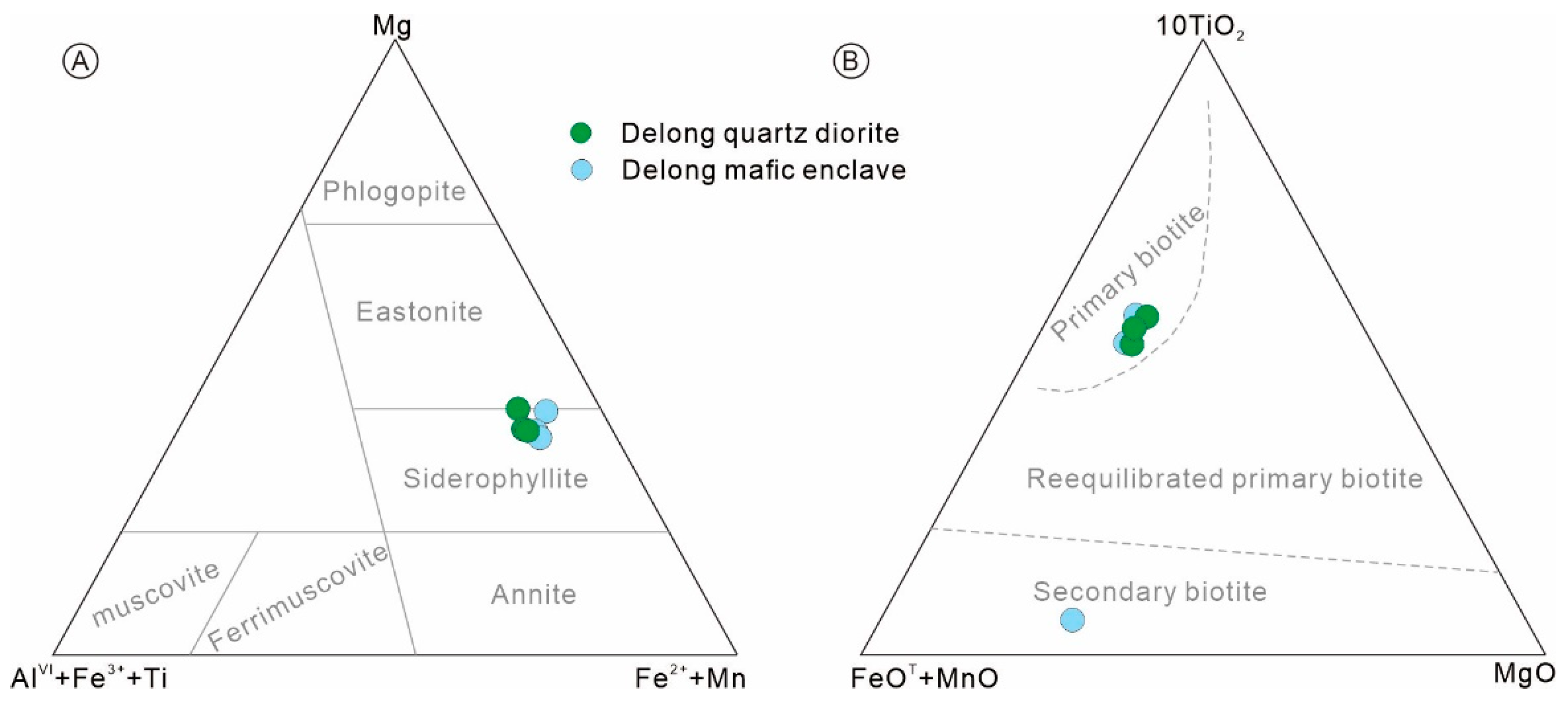
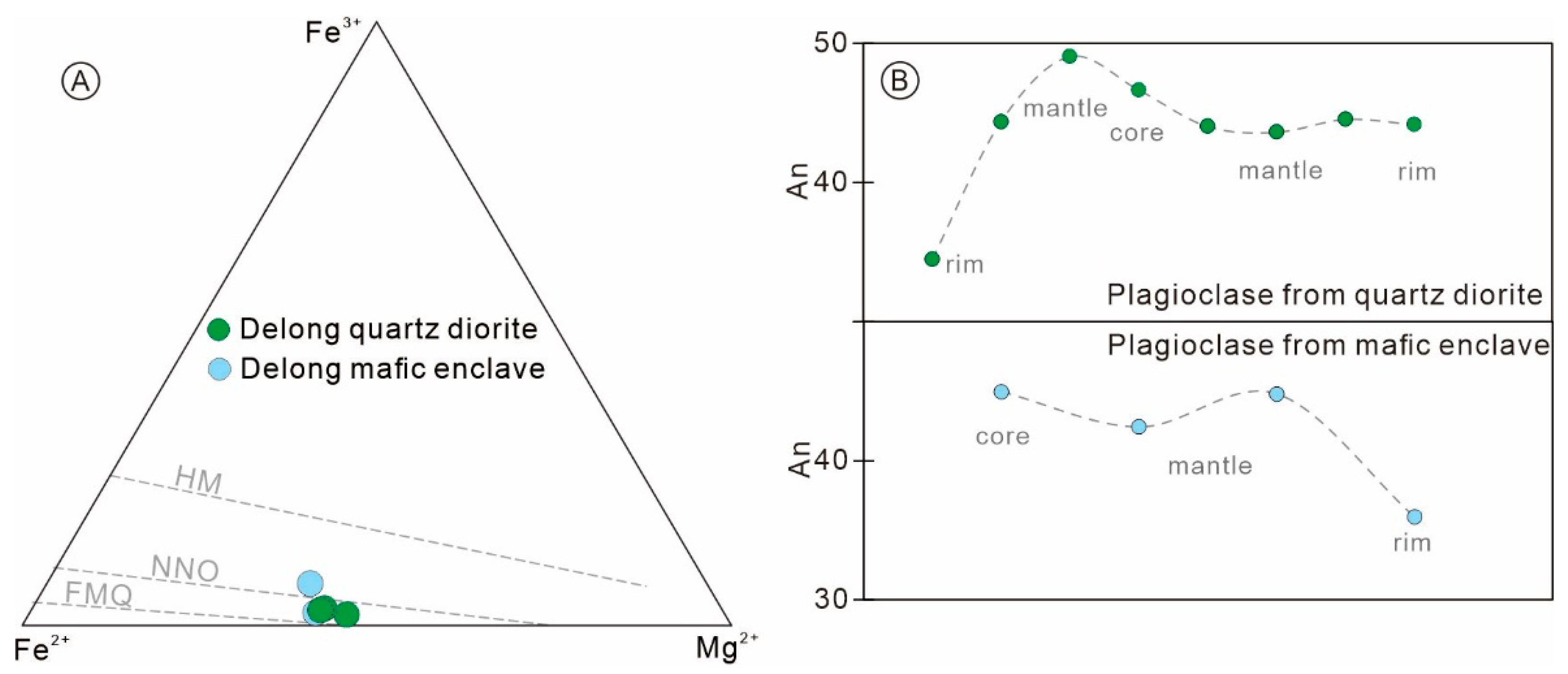


Disclaimer/Publisher’s Note: The statements, opinions and data contained in all publications are solely those of the individual author(s) and contributor(s) and not of MDPI and/or the editor(s). MDPI and/or the editor(s) disclaim responsibility for any injury to people or property resulting from any ideas, methods, instructions or products referred to in the content. |
© 2023 by the authors. Licensee MDPI, Basel, Switzerland. This article is an open access article distributed under the terms and conditions of the Creative Commons Attribution (CC BY) license (https://creativecommons.org/licenses/by/4.0/).
Share and Cite
Chen, J.; Fu, L.; Leng, C.; Zhao, X.; Ma, J.; Gao, H.; Xia, Y. Origin of Quartz Diorite and Mafic Enclaves in the Delong Gold-Copper Deposit and Evaluation of the Gold-Copper Mineralization Potential. Minerals 2023, 13, 1202. https://doi.org/10.3390/min13091202
Chen J, Fu L, Leng C, Zhao X, Ma J, Gao H, Xia Y. Origin of Quartz Diorite and Mafic Enclaves in the Delong Gold-Copper Deposit and Evaluation of the Gold-Copper Mineralization Potential. Minerals. 2023; 13(9):1202. https://doi.org/10.3390/min13091202
Chicago/Turabian StyleChen, Jiajie, Lebing Fu, Chengbiao Leng, Xu Zhao, Jian Ma, Hongze Gao, and Yu Xia. 2023. "Origin of Quartz Diorite and Mafic Enclaves in the Delong Gold-Copper Deposit and Evaluation of the Gold-Copper Mineralization Potential" Minerals 13, no. 9: 1202. https://doi.org/10.3390/min13091202
APA StyleChen, J., Fu, L., Leng, C., Zhao, X., Ma, J., Gao, H., & Xia, Y. (2023). Origin of Quartz Diorite and Mafic Enclaves in the Delong Gold-Copper Deposit and Evaluation of the Gold-Copper Mineralization Potential. Minerals, 13(9), 1202. https://doi.org/10.3390/min13091202





